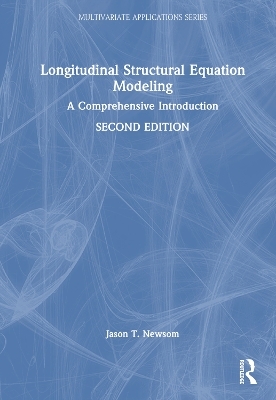
Longitudinal Structural Equation Modeling
Routledge (Verlag)
978-1-032-20283-9 (ISBN)
Longitudinal Structural Equation Modeling is a comprehensive resource that reviews structural equation modeling (SEM) strategies for longitudinal data to help readers determine which modeling options are available for which hypotheses.
This accessibly written book explores a range of models, from basic to sophisticated, including the statistical and conceptual underpinnings that are the building blocks of the analyses. By exploring connections between models, it demonstrates how SEM is related to other longitudinal data techniques and shows when to choose one analysis over another. Newsom emphasizes concepts and practical guidance for applied research rather than focusing on mathematical proofs, and new terms are highlighted and defined in the glossary. Figures are included for every model along with detailed discussions of model specification and implementation issues and each chapter also includes examples of each model type, descriptions of model extensions, comment sections that provide practical guidance, and recommended readings.
Expanded with new and updated material, this edition includes many recent developments, a new chapter on growth mixture modeling, and new examples. Ideal for graduate courses on longitudinal (data) analysis, advanced SEM, longitudinal SEM, and/or advanced data (quantitative) analysis taught in the behavioral, social, and health sciences, this new edition will continue to appeal to researchers in these fields.
Jason T. Newsom is professor of psychology at Portland State University, Portland, Oregon, USA.
Contents
List of Figures
List of Tables
Preface to the Second Editon
Preface to the First Edition
Acknowledgements
Example Data Sets
Chapter 1. Review of Some Key Latent Variable Principles
Chapter 2. Longitudinal Measurement Invariance
Chapter 3. Structural Models for Comparing Dependent Means and Proportions
Chapter 4. Fundamental Concepts of Stability and Change
Chapter 5. Cross-Lagged Panel Models
Chapter 6. Latent State-Trait Models
Chapter 7. Linear Latent Growth Curve Models
Chapter 8. Nonlinear Latent Growth Curve Models
Chapter 9. Nonlinear Latent Growth Curve Models
Chapter 10. Latent Class and Latent Transition
Chapter 11. Growth Mixture Models
Chapter 12. Intensive Longitudinal Models: Time Series and Dynamic Structural Equation Models
Chapter 13. Survival Analysis Models
Chapter 14. Missing Data and Attrition
Appendix A: Notation
Appendix B: Why Does the Single Occasion Scaling Constraint Approach Work?
Appendix C: A Primer on the Calculus of Change
Glossary
Index
| Erscheinungsdatum | 02.11.2023 |
|---|---|
| Reihe/Serie | Multivariate Applications Series |
| Zusatzinfo | 115 Line drawings, black and white; 115 Illustrations, black and white |
| Verlagsort | London |
| Sprache | englisch |
| Maße | 178 x 254 mm |
| Gewicht | 453 g |
| Themenwelt | Geisteswissenschaften ► Psychologie ► Allgemeine Psychologie |
| Studium ► Querschnittsbereiche ► Epidemiologie / Med. Biometrie | |
| Sozialwissenschaften ► Pädagogik ► Erwachsenenbildung | |
| ISBN-10 | 1-032-20283-1 / 1032202831 |
| ISBN-13 | 978-1-032-20283-9 / 9781032202839 |
| Zustand | Neuware |
| Haben Sie eine Frage zum Produkt? |
aus dem Bereich


